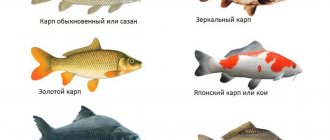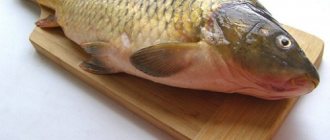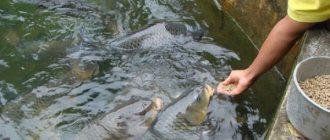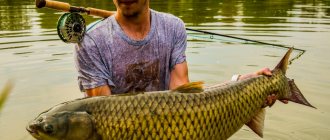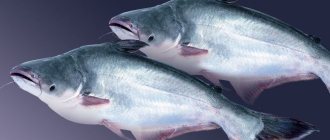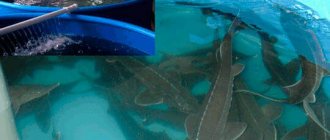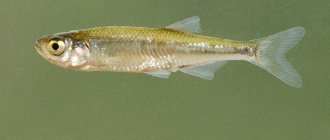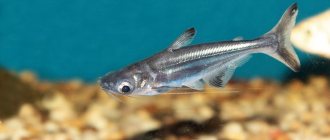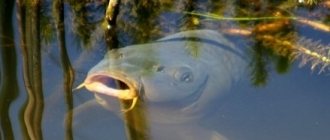Koi carps, or brocade carps as they are called, are ornamental fish that were bred from the Amur subspecies of carp. This type of carp usually includes fish that have passed 6 selective selections and are therefore included in this category. Today we know about a large variety of koi representatives that are found in Japan. As a rule, about 14 main subspecies were taken as a basis.
Origin
Koi carp is an aquarium fish of the carp family, which probably lives in a pond or in a spacious home tank. The origin story of the koi is very interesting and goes back to the old days.
Despite the fact that koi are called Japanese carp, the birthplace of the species is China. The word “Japanese” appeared in the name of the fish due to the fact that koi are now much more common in ponds in Japan rather than China.
Chinese carps appeared in Japan thanks to immigrants from China. The Japanese began calling the unusual fish "Magoi", which sounds like "black carp", and began raising koi carps in ponds. During the breeding process, some fish showed various deviations from the color standard, and the Japanese removed such individuals, leaving the fish to admire the beautiful color. Subsequently, this hobby grew into a real passion - the owners of decorative koi carp crossed their favorites with each other, getting new colored carp. The hobby became popular, and the fish were introduced to the public in 1914 during an exhibition in Tokyo. Now carps are actively distributed throughout Japan, and are considered a symbol of friendship and love.
Summarizing all of the above, we can conclude that the koi carp breed was obtained artificially and does not occur in the natural environment. In addition, according to approved guidelines, koi are considered to be those fish that have overcome strict selection, consisting of at least six phases.
Is it possible to eat
Koi carp are a variety of common carp and their meat is suitable for human consumption. But it is worth remembering that the Japanese have been breeding beautiful fish for many years and even in the most difficult years for Japan they found an opportunity to feed representatives of the aquatic world. At the same time, breeders monitored the quality of the offspring so that after a long time they could enjoy the beauty of these fish. All this time, personal interests and the desire to eat handsome people were sacrificed. It is difficult to say how many generations of breeders worked to create beautiful fish.
It is very impractical to cook any, even the most exquisite dishes from koi. The cost of these aquatic inhabitants is high; for the same amount of money you can buy less expensive common carp, crucian carp, carp or even trout. But if you want to show your well-being, no one can prevent this.
Adviсe
- Make sure that the surface on which the aquarium stands can support the weight of the pond. Keeping koi in an aquarium requires durable floors.
- When buying pet food, pay attention to the expiration date and compliance with storage conditions. Avoid loose feed.
- The water in the aquarium is free of cloudiness and foreign odors. If the water quality is low, increase filtration and aeration, and check the water with special tests.
- Fish sleep in complete darkness. Don't forget to turn off the lights at night.
- Combine biological and mechanical filtration. Purifying water with the help of colonies of beneficial bacteria will provide your pets with a full-fledged existence.
Koi carps are smart and charming aquarium fish. They remember the owner, feed from hands and even allow themselves to be petted. Feeding the fish can be accompanied by some sound, for example, knocking on the glass of the aquarium. Then the carp will react to the sound, realizing that it is time for lunch.
Previous Fishes8 common types of aquarium fish platies Next
FishGuppies and 19 compatible fish
Kinds
Koi are classified by body color, and there are many such species. For convenience, Japanese aquarists have combined fish species into 16 groups, bearing the following names:
- Kohaku is a variety with a light body, decorated with scarlet or orange spots.
- Taise Sanseku are light-colored fish with scarlet and jet-black markings.
- Seva Sanseku is a fish with a black color, complemented by scarlet and snow-white splashes.
- Utsurimono is a jet black koi with multi-colored markings.
- Bakko - the color of the fish is made in orange, red, light or yellowish tones. The body is dotted with dark spots.
- Tante - this variety differs from others in the scarlet spot adorning its head.
- Asagi is a fish with blue-gray scales and an orange belly.
- Shusui is a mirror-colored koi with large scales evenly spaced from head to tail.
- Koromo is a fish with scarlet and dark spots.
- Kingirin - varieties with different shades, the peculiarity is a pearlescent or golden tint.
- Kawarimono - this group includes representatives with a color unusual for other koi.
- Ogon - monochromatic phenotypes: gray, orange, scarlet or yellow.
- Hikari-moemono are fish with a steely sheen and various body colors.
- Goshiki are dark carps with scarlet, yellow or cornflower blue spots.
- Doitsu-goi - representatives are distinguished by large scales or the absence of them.
- Kumonryu are jet black fish with milky markings.
Each variety is beautiful and unique, and can become a real decoration for any pond or reservoir. The right light and a minimal amount of decorations will help to emphasize the elegance and grace of the koi.
Varieties of decorative "Japanese"
Koi carp has another name - brocade carp. This includes all colorful ornamental fish that have gone through at least 6 selections. Color is the main difference between koi and their wild relatives.
The most common color of the “Japanese” is red. Because of its scarlet hue, it is often called the red carp.
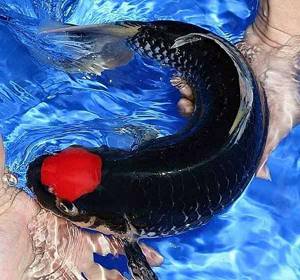
There are also fish of other colors, the so-called colored carps (ogon) in yellow, white and blue shades. In addition to single-color koi, there are variegated varieties - white with red and black spots (taise sanseku); yellow with white fins and black spots on the body (bekko); black Japanese carp with red or white spots (gosiki). There are varieties that have 5 combined shades. They have red, blue, blue, black spots on a white background. The spots themselves can also have a variety of patterns. The fish come with a golden or silver tint (kinginrin, hikarimuji).
Feeding
Japanese carp are unpretentious in matters of nutrition, and happily feast on both animal and plant foods. As natural live food, aquarists use:
- Bloodworms and brine shrimp.
- Cyclops and Daphnia.
- Shrimps.
- Worms, tadpoles and frog eggs.
When kept in an aquarium, it is recommended to use live food as a treat, and the basis of the diet should be commercial food for koi carp. It contains the necessary vitamins and minerals for growth, and additives that increase the richness of the color.
It is important to note that koi should not be overfed. Pets are fed three times a day, giving little food at a time. Remaining food is removed from the tank immediately.
Interesting fact: carp can go without feeding for about 7 days, so it’s okay if the owner forgets about feeding the fish.
Koi Ponds
To build a pond, you can use two materials: with a concrete base and with soft waterproofing. The latter uses synthetic rubber (EPDM). With its help you can create ponds of any shape and size. If there are sharp stones in the soil, then it is also necessary to use fleece (special backing), which will prevent damage to the EPDM film used. A pond with a concrete base is more expensive, but most durable. A concrete pond allows you to create steep vertical banks, which saves space while increasing the water volume of the pond. Recommended minimum pond dimensions: - depth from 1.4 m, - volume 8 tons (3 m x 2.46 m x 1.23 m). It should be remembered that koi are quite active fish, they need to swim, and accordingly they need a spacious pond. Naturally, there is no specific data on how deep and volume the pond should be, since it all depends on how many koi carps you want to put in the pond. Optimal pond location:
- a quiet, calm corner of the garden (as far as possible from noisy places, such as sports fields or roads), but close to the house (so that you can admire the koi in any weather without leaving the house);
- the rays of the sun should illuminate the reservoir/pond all day with a “lunch break” of 1.5-2 hours (there may be longer breaks, but this may affect some aquatic plants, for example, nymphs);
- during melting of snow or rain, water from the adjacent areas should not flow into the pond/reservoir (for this purpose, storm drainage is built around the pond or the pond is created elevated).
It is important to equip the pond with a two-stage filtration system: biological and mechanical. It must guarantee the effective removal of dissolved fish metabolites and suspended particles (fish excrement, plant debris and food) from the water, as well as maintain normal gas conditions. In a large flowing pond with a large number of aquatic plants, the filtration system, in principle, does not need to be used. But there is a high probability that koi will begin to eat underwater vegetation or dig through the soil in search of food (all plants may soon be dug up). The best options: 1) build an additional regeneration pond/reservoir with aquatic plants or 2) create a bioplato - a stream or small pond, entirely covered with pebbles with aquatic plants planted in it, through which water will circulate from the pond. Most of the factors that affect biological balance depend on the volume of the pond: the amount of dissolved oxygen, temperature conditions. Thus, the larger the pond, the easier it is to maintain biological balance.
Compatibility
Despite the fact that the nature of the contents of the koi carp in the aquarium is peaceful, experts recommend selecting neighbors of similar size and disposition. The ideal option is:
- Golden fish.
- Ancistrus.
- Plecostomus.
- Trout.
- Minnows.
- Other brocade carps.
It should be understood that if you move in with small fish, the latter will be eaten.
Interesting fact: koi carp are not only beautiful, but also smart. Over time, the pets get used to the owner, and even let him touch the shiny scales. In addition, the pets can be trained: if you knock on the glass before giving food to the fish, the carps will soon remember this.
Description of origin and natural habitat
Koi, translated from Chinese, means ordinary carp, brocade carp. However, there is some confusion in the classification. Thus, until recently, the Amur carp acted as a subspecies; today it is considered to be a separate species.
Unfortunately, there is no exact information about the origin of the fish. It is generally accepted that common carp entered China through traders or naturally. From China, the fish moved to Japanese reservoirs. Carps were first mentioned in written sources in the 14th century.
Breeding
Koi carp cannot be bred in a home artificial pond. The fact is that carp reach sexual maturity only with minimal dimensions (25 cm), which is possible when kept in a pond or in a huge tank - from 2,000 liters.
You can determine the sex of your pet when the fish reaches 25 cm in length:
- In males, the pectoral fins appear wider.
- Females have a slightly wider head and are more plump than boys.
Before breeding, male carp develop growths on their gills. In ponds, koi spawn in spring or summer, and it is important that the water temperature is at least 20C. For successful spawning, three male carp should be added to one female. Before breeding, pets are intensively fed with live food.
You should know that koi are not the most respectable parents, and after spawning they will eat eggs and babies without remorse. For safety reasons, the fish are resettled after laying their eggs in another place.
Small carp are born 7 days after laying eggs. They start feeding the babies when the fry are already swimming. For the growth and development of carp, it is important to take care of aeration and cleanliness of the aquatic environment.
Reproduction and lifespan
Koi carps that are kept in a pond and fed well also reproduce quickly. A lot of people are currently involved in carp breeding. Therefore, you can buy koi carp at very different prices.
The lower the price of koi carp , the worse the quality of the fish. Many breeders neglect the conditions necessary for keeping and breeding and therefore the resulting offspring have errors in structure, color or color.
Of course, such a fish is not suitable for an exhibition, however, it is quite acceptable for a home aquarium or pond in a summer cottage. Under good living conditions, a healthy individual can live with its owner almost his entire life, because on average a carp lives 50 years.

Typically, carp are ready to spawn when their size is 20-23 centimeters. The female is larger due to the eggs, the male is correspondingly smaller. A boy's pelvic fins are larger than those of a girl's. However, there are no clear differences between the female and the male of this artificially bred fish, because there have been cases when the male has smaller fins and a larger abdomen than the female.
The exact time of spawning can be determined by the bumps on the male’s head. They look like small specks that are difficult to see. As a rule, this occurs at the beginning of summer. Carp can spawn only with sufficient food. 20 degrees is enough for spawning to begin.
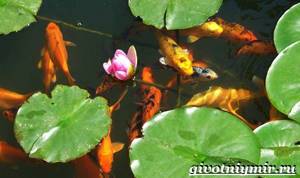
Typically, breeders are placed in an individual room - a large aquarium or pond. One female and several males are selected. During spawning, it is often worth changing the water and adding more live food. To prevent all the eggs and then the fry of the koi carp from being eaten by the parents, they are seized. In order for the fish to lay their eggs in a certain place, a nylon rope is used, which the carps perceive as a plant and lay their eggs on it.
Diseases
Carp diseases occur due to improper maintenance of fish and parasites that affect the internal organs and scales of pets. To prevent the development of diseases, you should know common diseases, their symptoms and methods of treatment:
- Rubella is a contagious disease. Outbreaks occur in the spring with an increase in water temperature, as a result of which the fish experience dysfunction of the excretory system. In 90% of cases, the disease is fatal. Methods to combat rubella are the use of chloramphenicol orally or using baths, increasing the pH level to 8.
- Saprolegniosis - manifests itself as a consequence of an illness or injury, the causative agent is considered to be a fungus. Light threads form on the body of the fish, which transform into plaque. As a result of the disease, pets become lethargic and lose their appetite. For treatment, use salt baths and 0.1% potassium permagnate lotions.
- Philometroidosis – carp of all ages are susceptible to this disease. The larvae of the parasite that causes phylometroidosis develop in the body of the fish, after which they are released into the aquatic environment, and the fish dies. As a result, other koi become infected - the pets lose mobility and lag behind in development. Therapeutic drugs are used to treat koi.
Japanese koi are amazing fish with incredible colors and intelligence. Keeping carp is easy, although it requires larger tanks and a clean water environment. Experienced aquarists note that it is better to breed carp in artificial ponds, because this is the only way to achieve offspring.
Koi food
Koi are omnivores, so their diet can be quite varied: pellets, soaked barley or bread, vegetables (e.g. carrots, lettuce), fruits (e.g. papaya, watermelon, oranges), pre-cooked frozen shrimp, pathogen-free live food (e.g. , insects, worms, undercooked shrimp). Pellet (food in the form of floating sticks) is a fairly common and safe food for fish. Advice: choose food from one particular well-known manufacturer and feed only that. For small koi, choose a small pellet size. Some types of food contain natural color enhancers (vitamin A or carotenoids): shrimp, fruit, spirulina. Small koi do not need additional food color enhancers, because this can harm their young and immature liver. You need to be careful with color enhancers, because prolonged feeding of koi carps with carotenoids can lead to a yellow color in the fish. The initially white color is a signal that the fish liver cannot cope with so much vitamin A. Some koi have white spots next to the red ones spots, become reddish or pinkish - a consequence of the same problem. If you prefer to feed carp several types of food (standard, vegetable, with added dyes), then it is better to create a feeding schedule for a certain period (for example, a week) and strictly follow it. Rules for feeding koi carp:
- fish should eat food within 5-10 minutes,
- feed should not pollute water,
- It’s better to underfeed than to overfeed,
- feed frequently (2-3 times a day) in small portions,
- the fish should receive daily feed equal to 3% of its own weight.
It is useless to give koi carp a large portion of food once a day, since they will not be able to digest everything at once - instead of a stomach, there is a long intestinal tract. Initial food for fry: artemia, daphnia, ciliates, wheat yeast, spirulina. Live food is recommended, but if this is not available, then a hard-boiled egg yolk will do. After a week, the fry can be fed with crushed pellets. When they reach 1.5 cm in length, they can be given small granules, which need to be increased in size as the fish grow.

